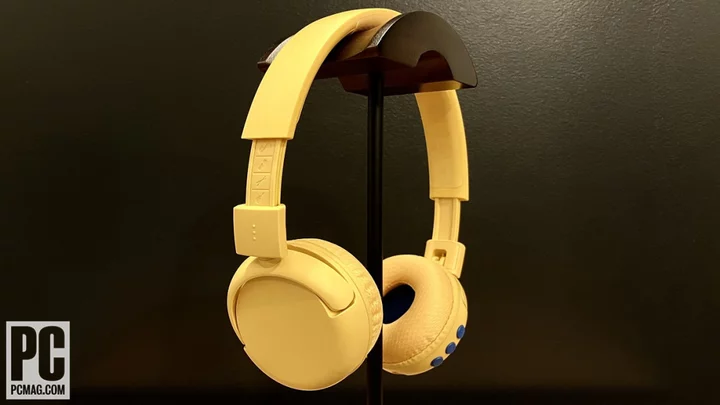The $39.99 Onanoff BuddyPhones Pop Fun offer everything we expect from a pair of kids' headphones: They sound balanced, feel comfortable, and don’t cost a lot. Kids should appreciate that they can adorn the pair with various stickers, while a wired listening mode adds versatility. That said, the overly loud 94dB max volume is too easy for children to turn on and the SBC-only Bluetooth playback limits the wireless audio quality. Ultimately, the more affordable Earfun K2 Kids headphones take our Editors’ Choice award because they produce more robust bass, support the AAC codec, and last longer per charge. Just keep in mind that your child might prefer the whimsical stylings of the BuddyPhones Pop Fun instead.
A Fun, Customizable Design
Available in blue, light green, white, or yellow, the BuddyPhones Pop Fun should fit like any other supra-aural (on-ear) pairs, though the earcups might cover younger listeners' ears entirely. Both the earpads and headband feature enough cushioning that they remain comfortable over long listening sessions. The earpads' jersey-like fabric lining and the headband's silicone exterior also improve the fit.
(Credit: Tim Gideon)Each model comes with a unique set of color-matched stickers your kid can use to cover the earcups. The shiny gold stickers that come with the yellow model, for instance, incorporate bumblebees, a giraffe, paw prints, and a turntable into the design. You can preview the stickers for each model on the Onanoff product page. Even without stickers, the headphone frame looks pretty cool, so kids with more minimalist tastes aren't left out. The braille L and R markings above the earcups are also a nice touch.
Internally, 40mm neodymium drivers produce a frequency range of 20Hz to 20kHz. The headphones are compatible with the older Bluetooth 5.0 standard (5.4 is the latest) and support just the SBC codec. These specs would be more forgivable if the less expensive Earfun K2 model didn't offer Bluetooth 5.4 and the AAC codec. What's important to note here is that most devices (including Amazon Fire tablets and the Nintendo Switch) support SBC, but AAC provides higher-quality sound on Apple devices in particular.
(Credit: Tim Gideon)The right earcup includes a central power/pairing button with flanking plus and minus buttons. That main button also manages playback (tap quickly to play or pause) and calls (press once to answer or end a call). Meanwhile, the plus and minus buttons handle volume changes (quick taps) and track navigation (long holds). I'm not a fan of combining these functions as it often leads to misfires, but this setup is typical for the category. Note that status LEDs on the right earcup flash blue every once in a while when the headphones have an active connection.
Pressing the plus and minus buttons at the same time switches between the Safe (85dB) and Pop (94dB) volume limiting modes. The status LEDs, which flash every 10 seconds or so, indicate which mode is active: two blue lights for Safe mode and three blue lights for Pop mode. These can help parents see the active volume setting at a glance, though the LEDs might prove distracting over time.
I appreciate that there's a way to limit the volume levels, but 94dB is too loud for children (and adults) for any extended period. Although this mode might come in handy for quieter recordings, its preset level and easy accessibility partially undermine the purpose of a volume limit in the first place. A single hard limit at 85dB would make much more sense if preventing hearing loss is the goal.
(Credit: Tim Gideon)The headphones ship with an audio cable for passive wired listening and a short USB-A-to-USB-C charging cable (both connections are on the right earcup). Like most kids' headphones, the BuddyPhones don't have a companion app, meaning you can't access an EQ or otherwise customize the experience.
Onanoff estimates that the BuddyPhones Pop Fun can last roughly 24 hours per charge, but your results will vary based on your typical listening levels. For reference, that's far shy of the 40-hour runtime of the Earfun K2 Kids.
Balanced Audio, Weak Mics
Your child likely won't be listening to the tracks I use for testing, but these varied recordings reveal the strengths and weaknesses of any given headphones. If they can handle these songs well, they certainly won't have any trouble with whatever popular Disney soundtrack your kid will play on a loop. I tried both the Safe and Pop modes but stuck with the former for my official tests since this is the mode your child should use.
On tracks with intense sub-bass content, like The Knife’s “Silent Shout,” the headphones produce a decent sense of bass depth, but not the subwoofer-like rumble we hear on regular headphones for adults. Volume levels indeed seem modest at the maximum settings in Safe mode, though not to the point that your child will complain that they can't hear their music.
Bill Callahan’s “Drover,” a track with far less deep bass in the mix, gives us a better sense of the audio signature. Drums sound subtle overall, with Callahan's baritone vocals getting the most lower-frequency energy. They also exhibit a pleasant low-mid richness and crisp high-mid presence. The higher-register percussive hits and acoustic strums are detailed and bright. Overall, the headphones sound balanced, with a focus on clarity.
(Credit: Tim Gideon)On orchestral tracks, like the opening scene from John Adams’ The Gospel According to the Other Mary, the BuddyPhones don't sound too thin or quiet. That said, some volume drop-offs are perceptible since classical tracks tend to have less dynamic compression than those within other genres. Even in Safe mode, the lower-register instrumentation has some body, while the higher-register brass, strings, and vocals retain their definition.
Not all kids' headphones have a mic system for taking calls. These do, but it's not very good. I had trouble understanding a test recording on my iPhone due to the faint and muffled signal. The EarFun K2 Kids headphones also have a somewhat quiet mic signal, but it's considerably crisper.
Expressive Style and Clean Sound
The Onanoff BuddyPhones Pop Fun are easy to customize, fit comfortably, and deliver clear sound. The included audio cable for passive listening partially makes up for the SBC-only Bluetooth limitation. We just wish it wasn't so easy for kids to activate the potentially damaging 94dB listening mode, which defeats the purpose of a volume limit. The Earfun K2 Kids headphones have that same flaw, but they still earn our Editors' Choice award for younger listeners thanks to their superior playback fidelity, deeper bass response, and lower price.









